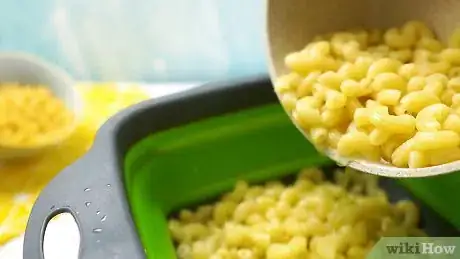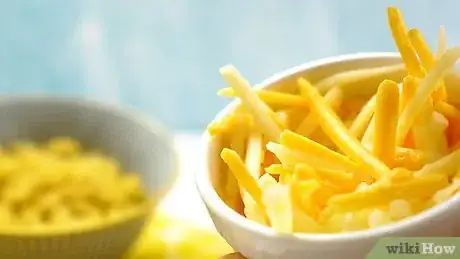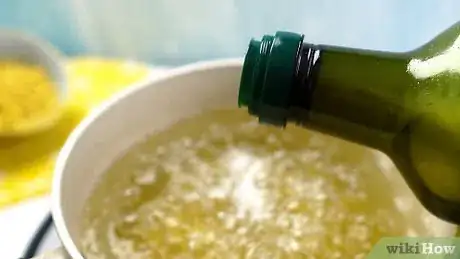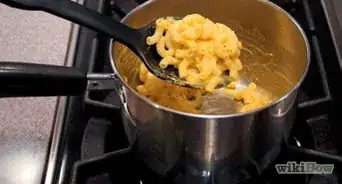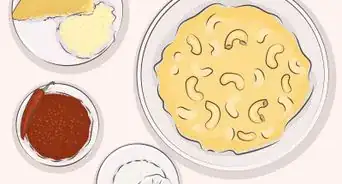This article was co-authored by wikiHow Staff. Our trained team of editors and researchers validate articles for accuracy and comprehensiveness. wikiHow's Content Management Team carefully monitors the work from our editorial staff to ensure that each article is backed by trusted research and meets our high quality standards.
There are 12 references cited in this article, which can be found at the bottom of the page.
The wikiHow Video Team also followed the article's instructions and verified that they work.
This article has been viewed 16,453 times.
Learn more...
Mac and cheese has a strong claim to the title of “king of comfort foods.” But all that starchy pasta and rich, gooey cheese can quickly open the door for sticky situations. Luckily, you can avoid getting yourself (and your dinner) into a bind by observing a few basic pasta-cooking principles, most of which come into play before you add a single shred of cheese.
Steps
Keeping the Cooked Pasta from Sticking
-
1Drain your pasta as soon as it’s done cooking. Once your noodles are perfectly tender, remove the pot from the cooktop and take it over to your kitchen sink, where you should have a colander or fine wire strainer waiting. Pour the contents of the pot out into the strainer carefully. Then, pick up the colander or strainer and shake it vigorously for a few seconds to coax out any remaining water trapped in the noodles.[1]
- The pot will be extremely hot when it first comes off the stove, so be sure to use a potholder or oven mitt to avoid burning yourself.
- Dumping the boiling water promptly will make it less likely to continue cooking the macaroni past its ideal texture.
-
2Rinse your cooked pasta with cold water if you’re not going to eat it right away. For those times when you’re prepping mac and cheese ahead of time, go ahead and give your noodles a good rinse right after you drain them. Doing so will not only help ensure that they don't accidentally overcook but also wash away any loose starch coating the outside.[2]
- After rinsing your macaroni, pack it up in a lidded food storage container or resealable plastic bag and stick it in the fridge. It should stay fresh for around 3-5 days.[3]
- When you’re ready to assemble the dish, all you’ll have to do is quickly reheat your pasta, whip up your sauce components, and simmer everything together until it’s nice and warm.
Advertisement -
3Choose cheeses that melt well for your base sauce. Tangy sharp cheddar and silky-smooth Monterey Jack are timeless favorites for many mac and cheese connoisseurs. However, you could also use another soft, flavorful type of cheese, such as Havarti or fontina. They’ll provide that creamy consistency you crave and won’t separate or harden into a concrete-like crust.[4]
- Mixing a little mozzarella into your cheese blend can help lend it some extra gooey goodness. Just be careful not to add too much, as this could make it stringy.
Warning: Stay away from hard, gritty cheeses like parmesan, as well as varieties that don't take well to melting, such as feta, manchego, or roquefort.[5]
-
4Transfer your finished mac and cheese to a serving dish while it’s still hot. Make it a point to spoon the cheesy pasta into a large bowl or casserole dish as soon as you take it off the heat. Most cheeses harden as they cool, so if you don’t want to have to use a chisel to get it out, it’s a good idea not to let it sit in the pot any longer than necessary.
- Scrape as much leftover sauce off the bottom and sides of the pot as you can to make doing the dishes later less of a chore.
- Generally speaking, non-stick cookware is best suited for preparing dishes that call for large quantities of cheese and other ingredients that have the potential to solidify quickly.[6]
Cooking Your Pasta Properly
-
1Fill the pot you plan on cooking with roughly ¾ of the way up with water. Make sure you’re starting with enough water to give your individual pieces of pasta plenty of breathing room. If your noodle-to-water ratio is too high, you could end up with one giant mass of macaroni on your hands, thanks to the sticky starch that escapes from the pasta as it heats up.[7]
- If you’re looking for more precise proportions, aim to use roughly 6 US quarts (5.7 L) for every 1 pound (0.45 kg) of dried pasta you’re preparing.[8]
-
2Bring your water to a full boil before you shake in the macaroni. Placing dried pasta in lukewarm water can cause it to clump or turn gummy as it cooks. Instead of submerging the noodles the second you see a few wisps of steam, wait until fat, roiling bubbles begin to form around the middle and sides of the pot.[9]
- Steam alone isn’t a good enough indicator that your water is sufficiently hot, since it will start to appear before the water reaches a proper boil.
- The idea that sprinkling a pinch of salt into your water will help it boil faster is a culinary myth. However, it can make the finished dish more flavorful, as long as you don’t go overboard.[10]
-
3Ignore the common advice to add oil to your cooking water. Many recipes recommend drizzling a little olive oil into the water as it comes to a boil to discourage sticking. The problem with this trick is that it works too well. It may keep your pasta from sticking together, but it will also keep the sauce from sticking to it later on.[11]
- As long as you cook your pasta correctly, it shouldn't be necessary to "lubricate" it with oil.
-
4Stir the macaroni continually as it cooks. Frequent stirring is probably your next best line of defense against sticking after starting with an ample amount of water. It’s especially important during the first couple of minutes that the noodles are exposed to heat—this is when they’ll release the largest quantity of glue-like starch.[12]
- Always use a wooden spoon to tend your pasta. Metal utensils absorb too much heat, and plastic ones may melt outright after spending a few seconds submerged in a pot of boiling water.[13]
- There’s no need to hover over the pot constantly. Just keep the macaroni moving through the water for the minute or two immediately after you put it in.
Tip: Be extra vigilant about stirring if you’re cooking with a smaller pot that doesn’t offer the pasta as much space to move around on its own.
-
5Cook your pasta until it's al dente or slightly less done. Overcooked pasta has a tendency to break down into a clumpy, mushy mess. To spare your macaroni this fate, take it off the heat around the time that it becomes supple and opaque. For 1 pound (0.45 kg) elbow or shell macaroni, this will usually take around 8-12 minutes.[14]
- Pasta can be a bit unpredictable when it comes to reaching optimal doneness, so be sure to keep an eye on your macaroni as it cooks and perform occasional taste tests, if needed.
Warnings
- Dried, burnt-on cheese is among the hardest substances to successfully scrub off of most types of cookware, so it's in your best interest to do everything you can not to let it reach that point.⧼thumbs_response⧽
Things You’ll Need
- Spacious pot
- Wooden spoon
- Colander or wire strainer
- Potholder or oven mitt
- Large serving dish
- Lidded storage container or resealable plastic bag (optional)
References
- ↑ https://www.rachaelraymag.com/food/how-to-cook-pasta
- ↑ https://www.insider.com/how-to-keep-pasta-noodles-from-sticking-together-2016-6
- ↑ https://www.bhg.com/recipes/how-to/food-storage-safety/storing-cooked-pasta/
- ↑ https://www.mashed.com/98332/tricks-making-creamiest-mac-cheese-ever/
- ↑ https://www.insider.com/the-best-cheeses-for-melting-2016-10
- ↑ https://www.cabotcheese.coop/how-to-melt-cheese
- ↑ https://www.smithsonianmag.com/arts-culture/youre-doing-it-wrong-the-guide-to-making-perfect-pasta-946855/
- ↑ https://www.rachaelraymag.com/food/how-to-cook-pasta
- ↑ https://www.insider.com/how-to-keep-pasta-noodles-from-sticking-together-2016-6
- ↑ https://www.eatthis.com/pasta-sticking/
- ↑ https://www.rachaelraymag.com/food/how-to-cook-pasta
- ↑ https://www.finecooking.com/article/cooking-pasta-properly
- ↑ https://www.finecooking.com/article/the-why-of-the-wooden-spoon
- ↑ https://whatscookingamerica.net/Pasta_Rice_Main/pasta.htm
- ↑ https://www.seriouseats.com/2017/01/how-to-use-cornstarch-and-evaporated-milk-to-make-stable-emulsion-cheese-sauce.html
